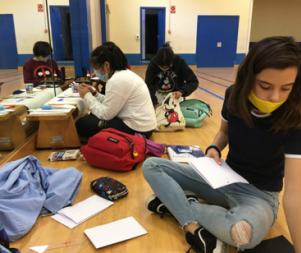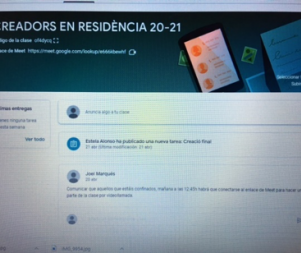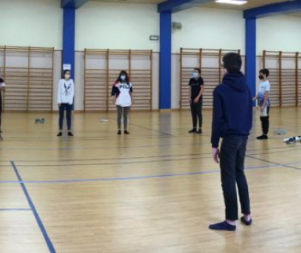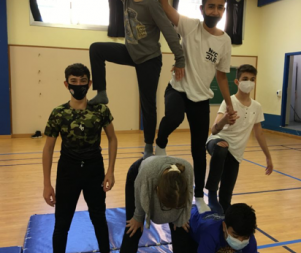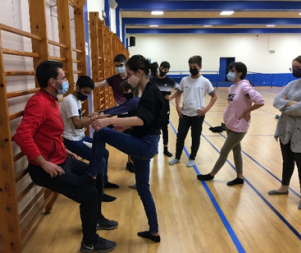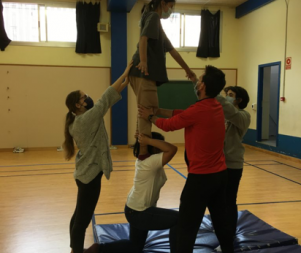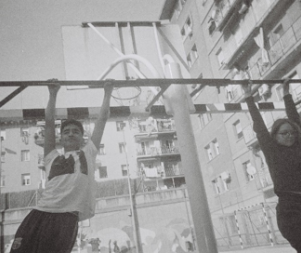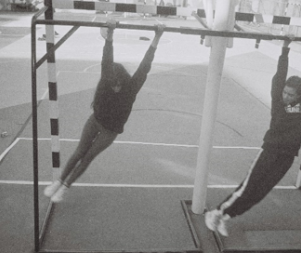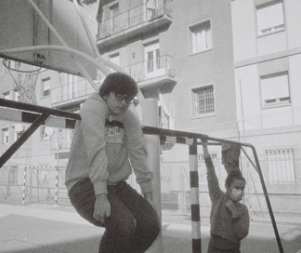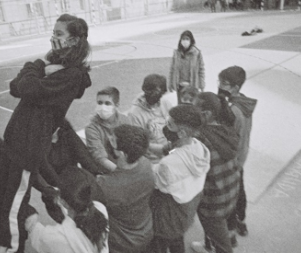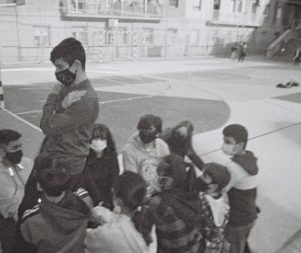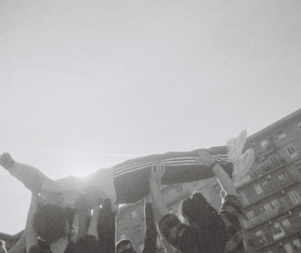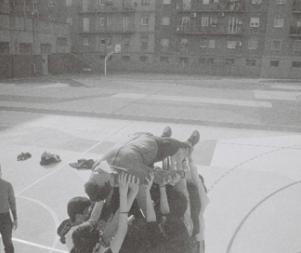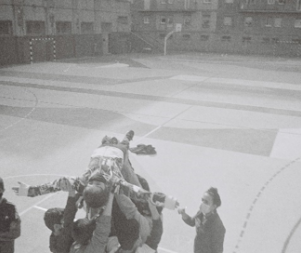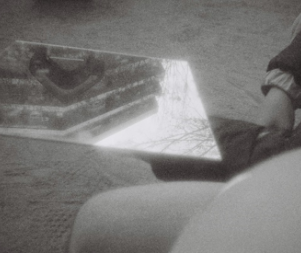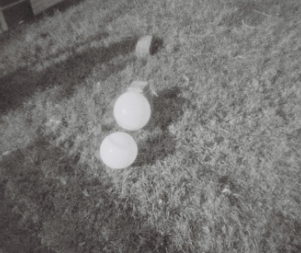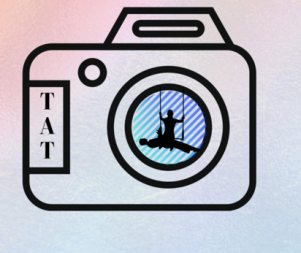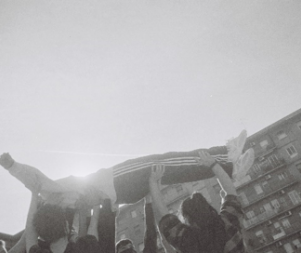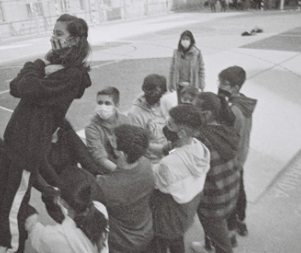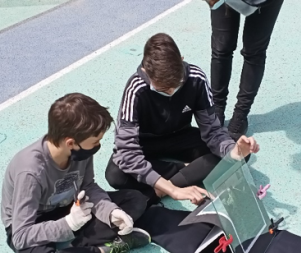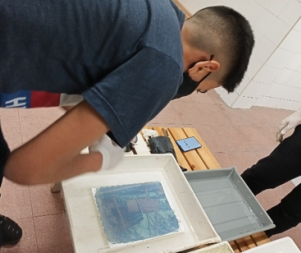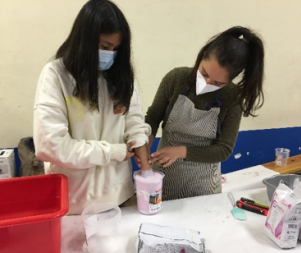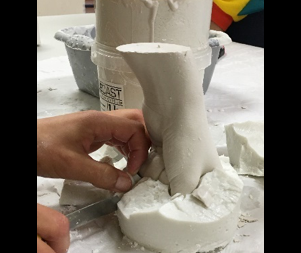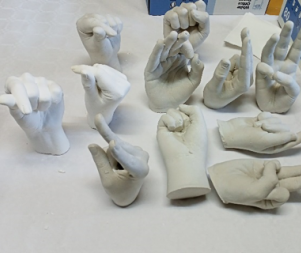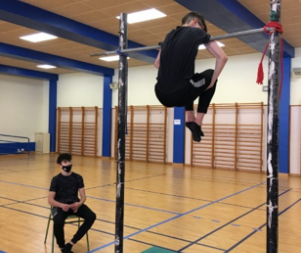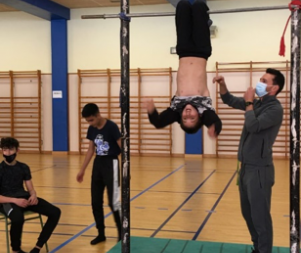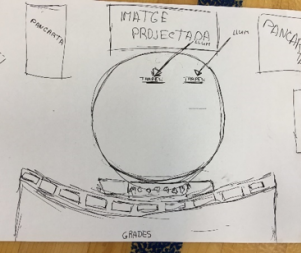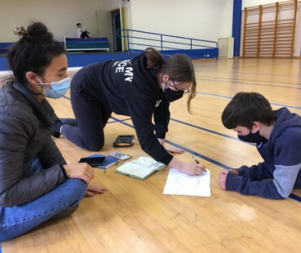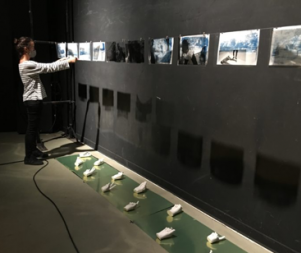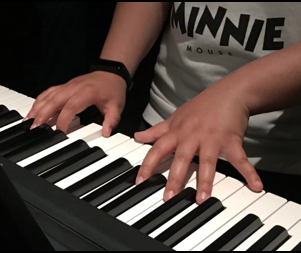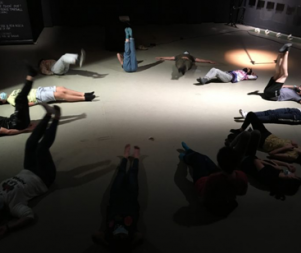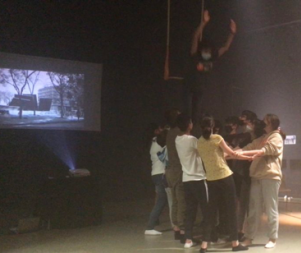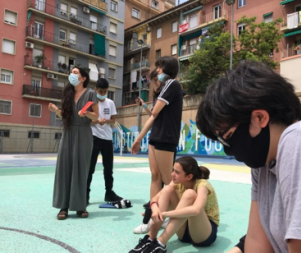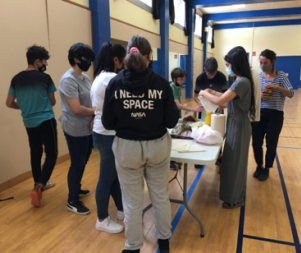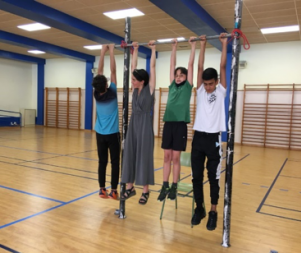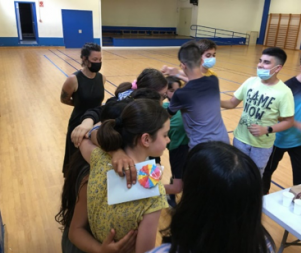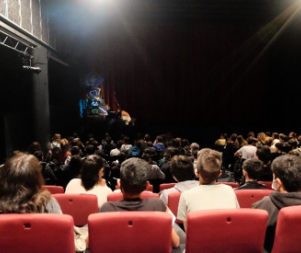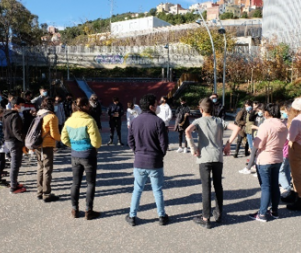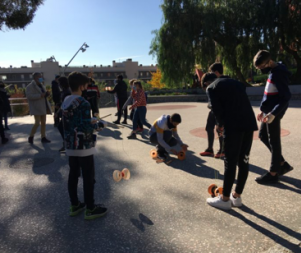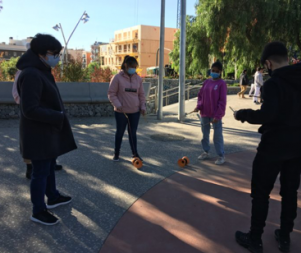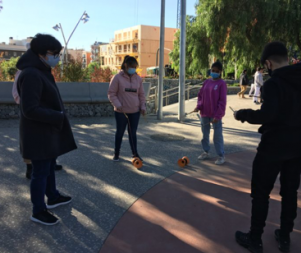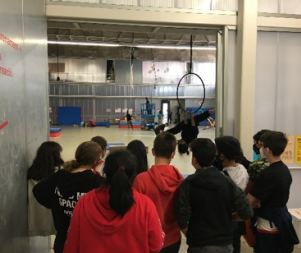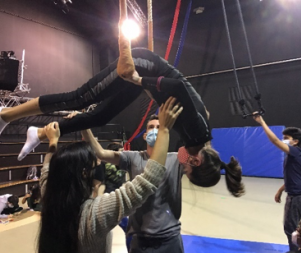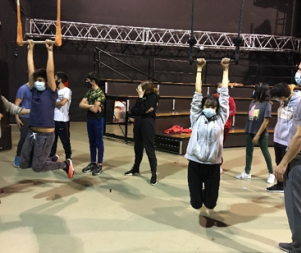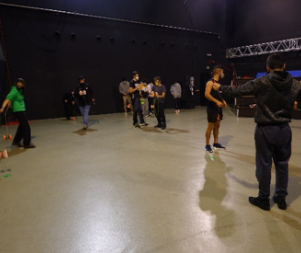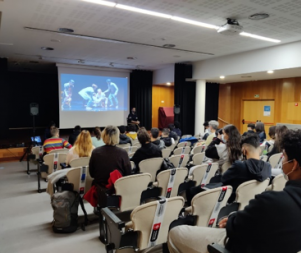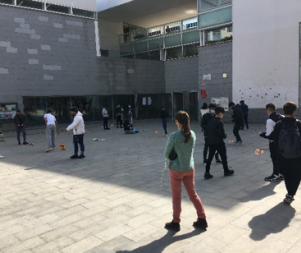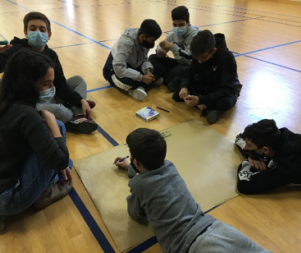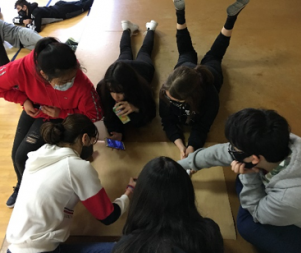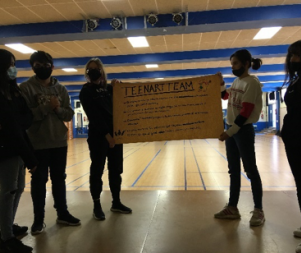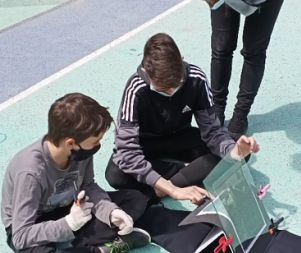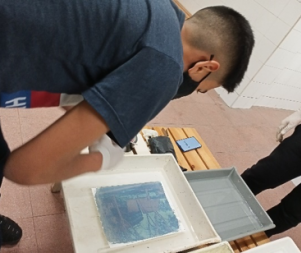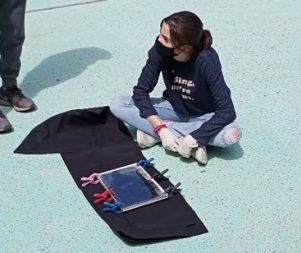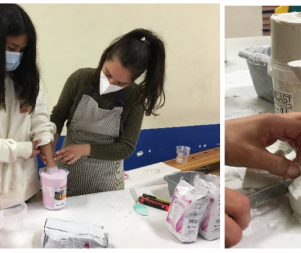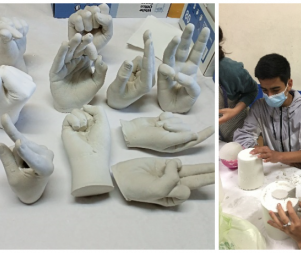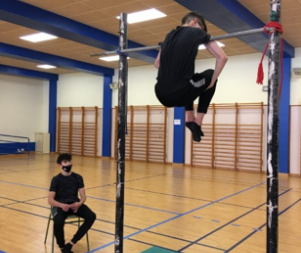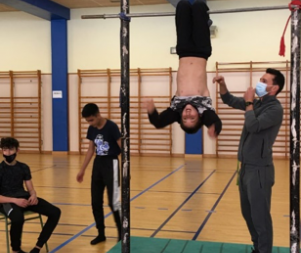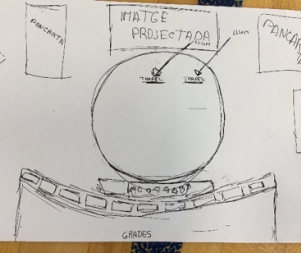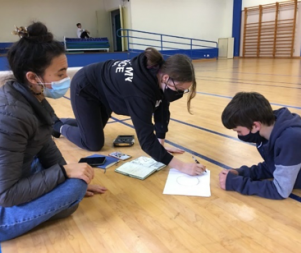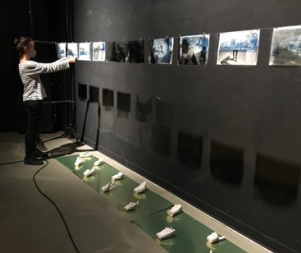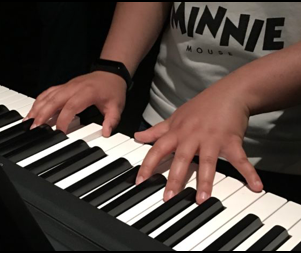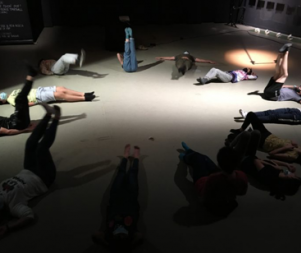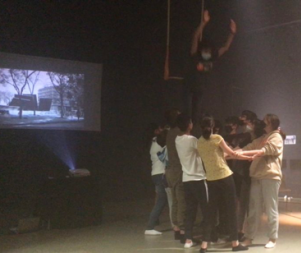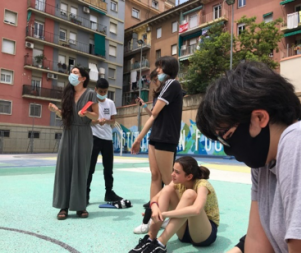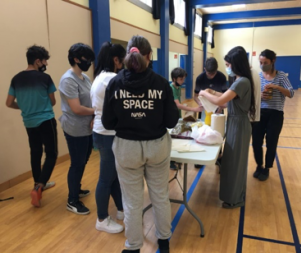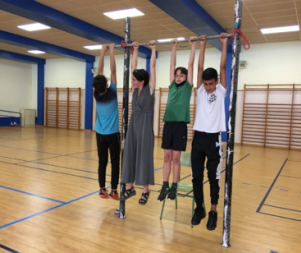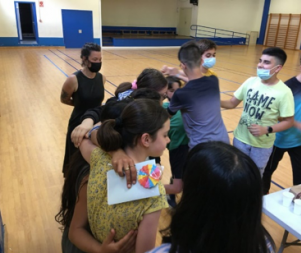- 14th EDITION 2022 / 2023
- 13th EDITION 2021 / 2022
- 12th EDITION 2020 / 2021
- 11th EDITION 2019 / 2020
- 10th EDITION 2018 / 2019
- 9th EDITION 2017 / 2018
- 8th EDITION 2016 / 2017
- 7th EDITION 2015 / 2016
- 6th EDITION 2014 / 2015
- 5th EDITION 2013 / 2014
- 4th EDITION 2012 / 2013
- 3rd EDITION 2011 / 2012
- 2nd EDITION 2010 / 2011
- 1st EDITION 2009 / 2010
Carla Farreny and Marta Vilardell IN RESiDENCE at the School Joan Fuster
LANDING: MUTUAL KNOWLEDGE
The process begins on 16 September with a visit by the creators and the intermediary Joan Fuster. An explanation of what would be done is given along with the first presentation with the group. There is a brief review of the techniques that would be used: the circus (trapeze), analogue photography and pottery, but the emphasis would be on the materiality of the three procedures. It is a bit difficult to understand the hybridisation between the three languages, but after a few days there was the opportunity to see an adaptation of the piece Tour by Carla’s company, at the Marés Museum, part of the Grec Festival Creation and Museums programme.
In the subsequent conversation there is a discussion about what an installation is, the circus elements that they saw in the work such as risk, suspension, the form of the body… and what makes the audiovisual, sound and body elements identifiable as circus and not any other performing art.
RECORDING THE PROCESS
In order to record the process, the desires, the initial expectations and how these change over time, a notebook-diary was created where what was happening during the different sessions was recorded individually, as well as the ideas between one meeting and another. A classroom is created in the Classroom app in order to share materials and maintain communication in the event of any lockdowns.
The material from the books is reviewed during the sessions in order to nurture the process and to help the group take ownership of it, with influences from singers, writers, artists, Instagrammers...
LANGUAGES
Carla began the body training sessions to get an idea of the potential, get the body into shape and begin practising suspension in order to commence with the trapeze as well as acrobalance to make balancing shapes as a group
After the suspension exercises at the gates to the yard, Carla asks “How do you feel? Are you afraid? Do you feel proud of what you have managed to do with your body? Do you feel any different physical sensations? Sore hands or stiffness?”
-Taking photos while they are suspended
-During the physical exercises with the group split into two. One half perform the exercise and the other half takes a picture of them.
-Take photos of a person balancing.
-Take photos from a “physical perspective” For example, while we are stretching, take photos of what we see from the perspective of our own body stretching.
-Photos of people jumping (idea Carla: photos of people floating).
-Working on suspension with light and dark. Trying images of what “you teach” and what “you do not teach”
-Take a photo of a person suspended seen from the reflection of a pool of water in the yard.
-Play with light/counter light and silhouettes.
GROUP CONSCIOUSNESS
An important part of the process is to generate a group consciousness from which to articulate a shared narrative. Symbolically, a key moment is when the group takes a name and becomes a collective. The name selection process highlights conflicts and differences of opinion, but finally, the name is decided upon which has both the feeling of belonging as well as the topic that now begins to be glimpsed: the transformation.
After a few meetings, it is decided that the group will be called TRANSFORMS ART TEAM, and one of the members creates a logo.
CREATION
During this phase of the process, decisions are taken to close the process and open it in a display.
They think about the topics and how they want to materialise them; the main principle is transition. Many of the group make reference to adolescence as a period of transformation from childhood to adolescence. This idea arises from the diversity of actions and is captured in several ways. With the body the Transition is questioned as what we do between one movement and another. A gesture that is impregnated with rhythm, intensity, intention and quality.
Through the photography, multiple sensations are depicted with the support of the group: floating, suspending and falling. The boys' changing room became a photographic laboratory and the group experimented with cyanotypes.
At the same time, they worked with clay, with the help of Natàlia they experimented with algin to make hand sculptures with which to capture a gesture, a moment in life marked by change.
WHAT DO WE DO AND WHAT DO WE MEAN TO SAY?
We work on the word TRANSFORM.
Why have we chosen this concept?
We thought that this concept of transformation resonated with the group of Creators, given that we are all living in a time of very important social transformation. At the same time we believe it is a topic that directly touches the life stage of the group of adolescents we are working with, who are facing this delicate passage from childhood to adulthood.
What were the reflections about this concept?
A phrase/idea that served as a guide to imagining the overall coherence of this creation is the following: HOW THE VOLATILE TRANSFORMS INTO SOMETHING PERMANENT AND HOW THE PERMANENT TRANSFORMS INTO SOMETHING VOLATILE.
An illustrative example of this idea would be the following: The hand as a transformative element of the external and the external as a transformative element of this hand. Like the hand of a sculptor, an artisan (a trapeze artist).
During all the exercises, we worked on the idea of this reciprocal transformation between ourselves and the environment, between the body and space. About this constant dialogue, what changes us and what makes us both evolve.
Through imagination and abstraction, we worked with the desire to give a new meaning to/transform/go beyond the known spaces and experiences within new imaginative possibilities.
FORMAT:
Exhibit and performance.
Everything happens within the same space/setting. The audience enters the space and travels between the different proposed stations, and at a given moment the young people's action commences, and they direct the audience to their seats.
STATIONS:
1) “fixation of ephemeral gestures”
-cyanotypes/transparencies: Imaginary spaces: we can refer to a known space through a new sensation. Reflection on what transforms us and what we transform.
-hands: fixation on the individual gesture, of a hand that will gradually transform. One can also think about sign language.
2) Creation process on video. Video story of the golden moments we had along the path travelled with the teenagers. Portrait of the creation process. This video is shown while the audience is wandering around, and they can view it from the middle of the stage or from the stands.
3) Stories of changing certainties. Placards showing certainties that we had when we were young, now and what we imagine they will be in the future. Stories of changing certainties. Black placard painted with a brush with chalk or white paint.
4) Performance: we have a fixed image in the background and an ephemeral physical group action. It is here in this station where what is static and what is ephemeral come together.
It is with these ideas that the training continues to prepare for the scenes of the performance. As there is no trapeze in the gymnasium, a structure was improvised to make it possible to experiment and practice.
Carla shows us the space at the Central del Circ to locate the improvisations and installation there.
CREATION RESIDENCE
For three days, the group carried out a creation residence in the Sala de Posada en Escena [Stage-Setting Room] at the Central del Circ. Over these three days, the group would decide on stage elements (lighting, smoke effects, the entry and exit of the audience…) and finalise how to close the scenes. Each person chooses the space they are more comfortable and in tune with, contributing knowledge and enthusiasm, improving day after day and feeling supported and accompanied by the group.
Close
Carla and Marta share what the experience has meant for them and how each one of the group has touched them. The group give out some thank you cards. And to finish, a small mid-morning snack.
Field trip- Even the Darkness, 25th WINTER CIRCUS AT THE SOCIOCULTURAL CENTRE, NOU BARRIS
The field trip to the Winter Circus is considered as a space for learning and reflection about the circus, also as an additional work session with the groups and, most importantly, a place for interaction and an exchange of experiences.
The show that we went to see is called Even the Darkness, it includes multiple disciplines such as acrobatics, trapeze, music… And it covers the different stages of the history of humanity; genesis, the Middle Ages, the modern age, the future…
Field trip - CENTRAL DEL CIRC
The visit to the Central del Circ is a very special moment for the groups as it helps them further immerse themselves into the professional aspect of the circus. After a visit to the facilities, they head off to the Sala de Posada en Escena for a work session.
Field trip - QUINZENA METROPOLITANA DE LA DANSA
Just like the previous course, this year we also attended an open display of the Quinzena Metropolitana de la Dansa. After various changes of day and location, we went to Fort Pienc with both groups.
The group led by Comas i Solà took the opportunity to make an audiovisual creation:
https://www.youtube.com/watch?v=_MATdbPx_qM
MASH-UP SESSIONS
Due to COVID-19 and the restrictions on gatherings, it was decided to adapt the mash-ups to a virtual format. Comas i Solà chose to do a presentation by video-conference to the teaching staff and students, giving a live explanation and demonstration.
The artists explained the creation process to Joan Fuster, and showed a video with the reflections of the group of youngsters.
https://www.youtube.com/watch?v=v0cQs3izWm8&t=127s
RESONANCES: COMMUNITY
The Circus and Education projects promote working locally and as a network.
With regard to the Central's links with the local area, they work together with the Barcelona Cultural District, the Civic Centre and the INS Barri Besòs school to create an educational programme together with the Caixa d’Eines group of INS Barri Besòs based on the Lazuz show, with the artists Ron Beeri and Itamar Glucksmann.
The group is also able to link up with the neighbouring district, Trinitat Vella, through the Civic Centre. Not only were part of the sessions carried out at the facilities, but when returning to the neighbourhood, a diabolo workshop was put on for the residents:

